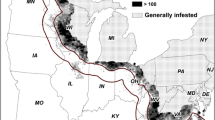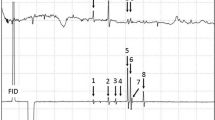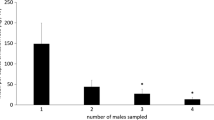Abstract
This four-year study demonstrated that low-density populations of the gypsy moth,Lymantria dispar (L.), were effectively suppressed by annual aerial application of 75 g of racemic disparlure per hectare formulated in plastic laminate flakes. These tests also showed that, when plots were treated with 150 g of pheromone per hectare in 1990 only and left untreated for the following three years, populations continued to be suppressed in 1991–1993 as compared with the controls. Although none of the plots were treated in 1994, population assessment continued and showed that the gypsy moth population density remained low in the plots that had been treated annually for the preceding four years. The laminate flakes released an average of 0.48 g disparlure per day per hectare from each of the two applications in 1990, and 0.72 g per day per hectare from the single application in each of the following three years (1991–1993). Only 27–40% of the applied pheromone dose was emitted during male moth flight.
Similar content being viewed by others
References
Berry, D. A. 1987. Logarithmic transformations in ANOVA.Biometrics 43:439–456.
Bierl, B. A., Beroza, M., andCollier, C. W. 1970. Potent sex attractant of the gypsy moth: Its isolation, identification, and synthesis.Science 170:87–89.
Carrol, R. J., andRuppert, D. 1988. Transformation and Weighting in Regression. Chapman and Hall, New York.
Cameron, E. A. 1981. The use of disparlure to disrupt mating, pp. 554–559,in C. C. Doane and M. L. McManus (eds.), The Gypsy Moth: Research toward Integrated Pest Management. USDA Tech. Bull. 1584, U.S. Department of Agriculture, Washington, D.C.
Charlton, R. E., andCardé, R. T. 1990. Orientation of male gypsy moths,Lymantria dispar (L.), to pheromone sources: The role of olfactory and visual cues.J. Insect Behav. 3:443–469.
Greenhouse, W. S., andGeisser, S. 1959. On methods in the analysis of profile data.Psychometrika 24:95–112.
Kolodny-Hirsch, D. M., Webb, R. E., Olsen, R., andVenables, L. 1990. Mating disruption of gypsy moth (Lepidoptera: Lymantriidae) following repeated ground application of racemic disparlue.j. Econ. Entomol. 83:1972–1976.
Kydonieus, A. F. 1980. Fundamental concepts of controlled release, pp. 1–19,in A. F. Kydonieus (ed.). Controlled Release Technologies: Methods, Theory, and Applications, Vol. 1. CRC Press, Boca Raton, Florida.
Leonard, D. S., Leonhardt, B. A., McLane, W. H., Ghent, J., Parker, S. K., Roland, T. J., andReardon, R. C. 1992. Aerial application of racemic disparlure to manage low-level populations of gypsy moth, Giles County, VA, 1989. USDA Forest Service, Northeastern Area State & Private Forestry Tech. Publ. 04-92, U.S. Department of Agriculture, Atlanta, Georgia.
Liebhold, A. M., Elkinton, J. S., Zhou, G., Hohn, M. E., Rossi, R. E., Boettner, G. H., Boettner, C. W., Burnham, C. andMcManus, M. L. 1995. Regional correlation of gypsy moth (Lepidoptera: Lymantriidae) defoliation with counts of egg masses, pupae, and male moths.Environ. Entomol. 24:193–203.
Mastro, V. C., Richerson, J. V., andCameron, E. A. 1977. An evaluation of gypsy moth pheromone-baited traps using behavioral observations as a measure of trap efficiency.Environ. Entomol. 6:128–132.
Mauchly, J. W. 1940. Significance test for sphericity of a normaln-variate distribution.Ann. Math. Stat. 11:204–209.
McGovern, T. E. 1994. USDA, APHIS-PPQ Gypsy Moth Treatment Data Base. U.S. Department of Agriculture, Hyattsville, Maryland.
McManus, M. L. 1973. The role of behavior in the dispersal of newly hatched gypsy moth larvae. USDA Forest Service Research Report NE-267, U.S. Department of Agriculture, Atlanta, Georgia.
Richerson, J. V. 1977. Pheromone-mediated behavior of the gypsy moth.J. Chem. Ecol. 3:291–308.
Richerson, J. V., Cameron, E. A., andBrown, E. A. 1976. Sexual activity of the gypsy moth.Am. Mid. Nat. 95:299–312.
SAS Institute. 1985 SAS/STAT guide for personal computers, version 6. SAS Institute, Cary, North Carolina.
Schwalbe, C. P., andMastro, V. C. 1988. Gypsy moth mating disruption: dosage effects.J. Chem. Ecol. 14:581–588.
Schwalbe, C. P., Paszek, E. C., Webb, R. E., Bierl-Leonhardt, B. A., Plimmer, J. R., McComb, C. W., andDull, C. W. 1979. Field evaluation of controlled release formulations of disparlure for gypsy moth mating disruption.J. Econ. Entomol. 72:322–326.
Schwalbe, C. P., Paszek, E. C., Bier-Leonhardt, B. A., andPlimmer, J. R. 1983. Disruption of gypsy moth (Lepidoptera: Lymantriidae) mating with disparlure.J. Econ. Entomol. 76:841–844.
Sharov, A. A., Liebhold, A. M., andRavlin, F. W. 1995. Prediction of gypsy moth (Lepidoptera: Lymantriidae) mating success from pheromone trap counts.Environ. Entomol. 24:1239–1244.
Wallner, W. E., Devito, A. S., andZarnoch, S. J. 1989. Regression estimators for late-instar gypsy moth larvae at low population densities.For. Sci. 35:789–800.
Wallner, W. E., Jones, C. G., Elkinton, J. S., andParker, B. L. 1990. Sampling low density gypsy moth populations,in Proceedings USDA Gypsy Moth Research Review. Annapolis, Maryland.
Webb, R. E., McComb, C. W., Plimmer, J. R., Bierl-Leonhardt, B. A., Schwalbe, C. P., andAltman, R. M. 1981. Disruption along the “leading edge” of the infestation, pp. 560–570,in C. C. Doane and M. L. McManus (eds.). The Gypsy Moth: Research toward Integrated Pest Management. USDA Tech. Bull. 1584, U.S. Department of Agriculture, Washington, DC.
Webb, R. E., Tatman, K. M., Leonhardt, B. A., Plimmer, J. R., Boyd, V. K., Bystrak, P. G., Schwalbe, C. P., andDouglass, L. W. 1988. Effect of aerial application of racemic disparlure on male trap catch and female mating success of gypsy moth (Lepidoptera: Lymantriidae).J. Econ. Entomol. 81:268–273.
Webb, R. E., Leonhardt, B. A., Plimmer, J. R., Tatman, K. M., Boyd, V. K., Cohen, D. L., Schwalbe, C. P., andDouglass, L. W. 1990. Effect of racemic disparlure released from grids of plastic ropes on mating success of gypsy moth (Lepidoptera: Lymantriidae) as influenced by dose and by population density.J. Econ. Entomol. 83:910–916.
Wilson, Jr., R. W., andFontaine, G. A. 1978. Gypsy moth egg-mass sampling with fixed-and variable-radius plots. USDA Handbook No. 523. U.S. Government Printing Office, Washington, D.C.
Author information
Authors and Affiliations
Rights and permissions
About this article
Cite this article
Leonhardt, B.A., Mastro, V.C., Leonard, D.S. et al. Control of low-density gypsy moth (Lepidoptera: Lymantriidae) populations by mating disruption with pheromone. J Chem Ecol 22, 1255–1272 (1996). https://doi.org/10.1007/BF02266964
Received:
Accepted:
Issue Date:
DOI: https://doi.org/10.1007/BF02266964




